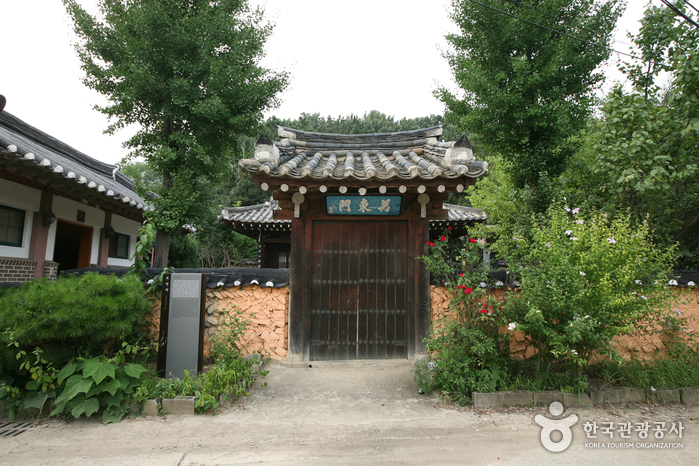Space M - Hyundai Outlets Daegu Branch [Tax Refund Shop] (스페이스M 현대아울렛 대구점)
6.4Km 2024-04-22
454, Dongdaegu-ro, Dong-gu, Daegu
-
Hyundai City Outlets - Daegu Branch [Tax Refund Shop] (현대시티아울렛 대구)
6.4Km 2024-04-18
454, Dongdaegu-ro, Dong-gu, Daegu
-
Olive Young - Daegu Daehyeon Branch [Tax Refund Shop] (올리브영 대구대현)
6.4Km 2024-04-18
Store #106, #107, Gangnam Medical Tower, 111, Sinam-ro, Buk-gu, Daegu
-
Korean Traditional Culture Center (한국전통문화체험관)
6.9Km 2025-10-23
13-5 Dalgubeol-daero 527-gil, Suseong-gu, Daegu
+82-53-666-4930
Momyeongjae is an ancestral shrine built by the Dureung Doo clan to honor Doo Sa-chung, who had joined the Ming Dynasty's reinforcement troops during the Imjinwaeran (Japanese invasion of Korea, 1592) and later became naturalized in Joseon Dynasty. The name 'Momyeongjae' means 'longing for the Ming Dynasty,' expressing Doo Sa-chung's affection for his home country.
Doo Sa-chung, who was from Duling, China, went to Joseon under the command of General Li Rusong from the Ming Dynasty. Doo Sa-chung took the position titled Suryuk Jihoek Jusa and was responsible for selecting locations to establish a stronghold in consideration of the terrain. As a senior adviser to Li Rusong, he closely discussed strategies and tactics with the Joseon army as well.
When the war was over, Doo Sa-chung returned to China but went to Joseon again during the Jeongyujaeran (Japanese invasion of Korea, 1597). He brought his two sons -- Doo San and Doo Il-geon -- along with his brother-in-law, Admiral Chen Lin. When the war was over, Doo Sa-chung and his two sons naturalized in Joseon. The government of Joseon granted him land, which is the current Gyeongsang Gamyeong Park area.
When the Gyeongsang Gamyeong (Gyeongsang provincial office) was relocated to this area, Doo Sa-chung offered his land to the government and moved to Gyesan-dong.
Longing for his wife and brothers he had left in China, he moved again to a village near Daedeoksan Mountain (then Choejeongsan Mountain) and named the area Daemyeong-dong (meaning the Great Ming). He built a platform and on the first day of every month, he would bow in the direction of the Forbidden City in China, where the Emperor of the Ming Dynasty resided.
Momyeongjae is built on a rectangular plot and faces south. It features a hip-and-gable roof with double-layer eaves and has four rooms in the front and two rooms on the side. The daecheongmaru (wooden floor hall) has two ondol (floor heated) rooms on each of its side, with a half-sized bay at the front. Momyeongjae exemplifies the early 20th-century ancestral shrine style commonly found in the Daegu area.
The building was originally constructed in 1912 when Doo Sa-chung’s descendants moved wooden materials from the dismantled Gyeongsangaeksa (local government building) and used them to build Momyeongjae in front of Doo Sa-chung's tomb. The shrine was later renovated in 1966 as it was in poor condition.
Momyeongjae is one of the first destinations visited by Chinese tourists in Daegu. It was recently renovated as part of a redevelopment project. The Korean Traditional Culture Center opened nearby, where visitors can experience tea ceremonies, hanbok (traditional Korean clothing), archery, and cooking dishes based on Donguibogam, a traditional Korean medical encyclopedia. Joining a program at the center will be a valuable experience.
Lotte Himart - Chimsan Branch [Tax Refund Shop] (롯데하이마트 침산점)
7.0Km 2024-04-18
598, Jungang-daero, Buk-gu, Daegu
-
Olive Young - Suseong-gu Office Station Branch [Tax Refund Shop] (올리브영 수성구청역)
7.1Km 2024-04-18
2518, Dalgubeol-daero, Suseong-gu, Daegu
-
Daegu Chilseong Market & Chilseong Night Market (대구 칠성시장&별별상상 칠성야시장)
7.1Km 2023-11-22
28 Chilseongsijang-ro, Buk-gu, Daegu
+82-53-621-1985
Chilseong Market is one of Daegu's largest traditional markets, along with Seomun Market. The market has had a range of names over the years, but was founded as Chilseong Market in 1946 when it became a permanent market open all year round. Shops within the market sell everything from fruits and vegetables to fish, flowers, and household goods, as well as various restaurants.
The Chilseong Night Market has been running since 2019, offering over 60 different foods, arts and crafts, and even performance programs.
Museum of Natural Dye Arts (자연염색박물관)
7.2Km 2021-03-19
17, Pagye-ro 112-gil, Dong-gu, Daegu
+82-53-981-4330
The Museum of Natural Dye Arts was formed to collect and preserve the traditional way of dyeing, as well as inform the high quality of Korean natural dye to the world. The museum has various art products from around the world. Divided into two floors, Ahwon Gallery on the first floor showcases replicas of ancient dyeing tools and provides information on the natural dyeing process. The Relic Hall on the second floor displays pieces of ancient artwork including fabric, clothes, pillows, blankets and accessories, all made using different methods such as dyeing, embroidery, quilting, knotting and sewing.

![Space M - Hyundai Outlets Daegu Branch [Tax Refund Shop] (스페이스M 현대아울렛 대구점)](http://tong.visitkorea.or.kr/cms/resource/84/2883884_image2_1.jpg)
![I Love J [Tax Refund Shop] (I LOVE J)](http://tong.visitkorea.or.kr/cms/resource/92/2883892_image2_1.jpg)
![Hyundai City Outlets - Daegu Branch [Tax Refund Shop] (현대시티아울렛 대구)](http://tong.visitkorea.or.kr/cms/resource/83/2883883_image2_1.jpg)
![Olive Young - Daegu Daehyeon Branch [Tax Refund Shop] (올리브영 대구대현)](http://tong.visitkorea.or.kr/cms/resource/87/2888487_image2_1.jpg)

![Lotte Himart - Chimsan Branch [Tax Refund Shop] (롯데하이마트 침산점)](http://tong.visitkorea.or.kr/cms/resource/25/2883925_image2_1.jpg)
![Olive Young - Suseong-gu Office Station Branch [Tax Refund Shop] (올리브영 수성구청역)](http://tong.visitkorea.or.kr/cms/resource/42/2884142_image2_1.jpg)

 English
English
 한국어
한국어 日本語
日本語 中文(简体)
中文(简体) Deutsch
Deutsch Français
Français Español
Español Русский
Русский